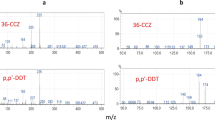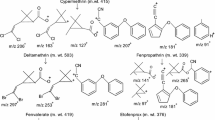Summary
Degradation products of chlorsulfuron, chlortoluron, diuron, fluometuron, isoproturon, linuron, metabenzthiazuron, metobromuron, and monuron formed in the gas chromatographic injector have been used for identification of the respective herbicides. Mass spectra of the derived compounds were obtained with a quadrupole mass spectrometric detector working in scan mode (20–450 amu). The compounds generated often depended on the solvent used for phenylurea herbicide injection (ethanol, methanol, dichloromethane, and acetonitrile). When methanol and ethanol were used as solvents the major products formed from phenylureas were carbamic acid esters. When acetonitrile or dichloromethane were used the main derivatives were phenylisocyanates. Chlorsulfuron and metabenzthiazuron, however, generated a triazine plus a phenylsulfonamide and a benzothiazolamine, respectively, irrespective of the solvent used. Linuron and diuron behaved similarly and gave degradation products with the same mass spectra. The thermal reactions occurred instantaneously in the injector block and were promoted by the high temperature selected (300°C).
Detemination of the compounds derived from urea herbicides, by use of a 30 m BP10 column and a selected ion registering (SIR) program based on two or three ions, can be used for sensitive detection of the presence of urea herbicides in environmental extracts. With standards in methanol instrument detection limits ranged from 0.1 pg for chlorsulfuron (detected as 2-chlorobenzensulfonamide) to 1 pg for monuron and metobromuron (both detected as their carbamic acid methyl esters).RSD were below 9% at the 5 ng L−1 level. The response was linearly dependent on quantily (r>0.9986) in the 5 ng L−1 to 25 μg L−1 range. Unequivocal identification of some phenylurea herbicides was not always possible because some herbicides with similar structures, for example diuron and linuron, gave the same derivative.
Similar content being viewed by others
References
Strek, H.J.Pestic. Sci. 1998,53, 29–51.
Strek, H.J.Pestic. Sci. 1998,53, 52–70.
Chiron, S.; Dupas, S.; Scribe, P.; Barceló, D.J. Chromatogr. A 1994,665, 295–305.
Liu, C.-H.; Mattern, G.C.; Yu, X.; Rosen, R.T.; Rosen, J.D.J. Agric. Food Chem. 1991,9, 718–723.
Mattina, M.J.I.J. Chromatogr. 1991,549, 237–245.
Aguilar, C.; Ferrer, I.; Borrull, F.; Marcé, R.M.; Barceló, D.J. Chromatogr. A 1998,794, 147–163.
Krynitsky, A.J.JAOAC Int. 1997,80, 392–400.
D'Ascenzo, G.; Gentili, A.; Marchese, S.; Marino, A.; Perret, D.Environ. Sci. Technol. 1998,32, 1340–1347.
Marek, L.J.; Koskinen, W.C.J. Agric. Food Chem. 1996,44, 3878–3881.
Bossi, R.; Koppen, B.; Spliid, N.H.; Streibig, J.C.JAOAC Int. 1998,81, 775–784.
Crescenzi, C.; Di Corcia, A.; Guerriero, E.; Samperi, R.Environ. Sci. Technol. 1997,31, 479–488.
Hogenboorn, A.C.; Speksnijder, P.; Vreeken, R.J.; Niessen, W.M.A.; Brinkman, U.A.T.J. Chromatogr. A 1997,777, 81–90.
Hogenboorn, A.C.; Niessen, W.M.A.; Brinkman, U.A.T.J. Chromatogr. A 1998,794, 201–210.
Albanis, T.A.; Hela, D.G.J. Chromatogr. A 1995,707, 283–292.
Bengtsson, S.; Ramberg, A.J. Chromatogr. Sci. 1995,33, 554–556.
Patsias, J.; Papadopoulou-Mourkidou, E.J. Chromatogr. A 1996,740, 83–98.
Tekel, J.; Schultzová, K.; Kovacicova, J.; Brandsterterová, E.J. High. Resol. Chromatogr. 1993,16, 126–128.
Tekel, J.; Schultzová, K.; Farkas, P.; Kovacicova, J.; Brandsterterová, E.J. High. Resol. Chromatogr. 1991,14, 423–424.
Bernal, J.L.; del Nozal, Ma. J.; Martin, M.T.; Jiménez, J.J.J. Chromatogr. A 1996,754, 245–256.
Pérez, S.; García-Baudín, J.M.; Tadeo, J.L.Fresenius J. Anal. Chem. 1991,339, 413–416.
Long, A.R.; Hsieh, L.C.; Malbrough, M.S.; Short, C.R.; Barker, S.A.J. Assoc. Off. Anal. Chem. 1989,72, 813–815.
Pérez, S.; Matienzo, M.T.; Tadeo, J.L.Chromatographia 1993,36, 195–200.
D'Amato, A.; Semeraro, I.; Bicchi, C.JAOAC Int. 1993, 76, 657–662.
Gelsomino, A.; Petrovicová, B.; Tiburtini, S.; Magnani, E.; Felici, M.J. Chromatogr. A 1997,782, 105–122.
Lanças, F.M.; Rissato, S.R.J. Microcolumn Sep. 1998,10, 473–478.
Liao, W.; Joe, T.; Cusick, W.G.,J. Assoc. Off. Anal. Chem. 1991,74, 554–565.
Mattern, G.C.; Singer, G.M.; Louis, J.; Robson, M.; Rosen, J.D.J. Assoc. Off. Anal. Chem. 1989,72, 970–974.
Wimmer, M.J.; Smith, R.R.J. Agric. Food Chem. 1991,39, 280–286.
Long, A.R.; Charkhian, B.; Hsieh, L.C.; Short, C.R.; Barker, S.A.J. Chromatogr. 1990,505, 395–401.
Author information
Authors and Affiliations
Rights and permissions
About this article
Cite this article
Berrada, H., Font, G. & Moltó, J.C. Influence of the solvent on the gas chromatographic behaviour of urea herbicides. Chromatographia 54, 253–262 (2001). https://doi.org/10.1007/BF02492254
Received:
Revised:
Accepted:
Issue Date:
DOI: https://doi.org/10.1007/BF02492254




